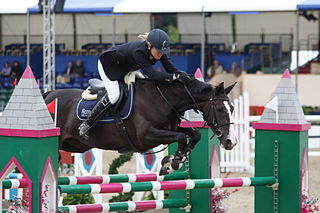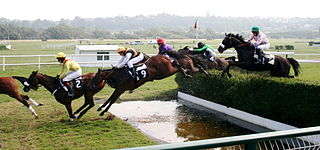National Hunt racing is a form of horse racing particular to France, Great Britain and Ireland, that requires horses to jump fences and ditches. In the UK, it is divided into two major distinct branches, hurdling and steeplechase, as well as flat races called "bumpers". Hurdling involved the horses jumping over obstacles called hurdles, whereas in a steeplechase the horses jump over a variety of obstacles that includes plain fences, water jump or an open ditch. In the UK, the biggest National Hunt events of the year are generally considered to be the Grand National and the Cheltenham Gold Cup.

The Selle Français (SF) is a breed of sport horse from France. An athletic horse with good gaits, it is usually bay or chestnut in color. The Selle Français was created in 1958 when several French riding horse breeds were merged into one stud book. The new breed was meant to serve as a unified sport horse during a period when horses were being replaced by mechanization and were transforming into an animal used mainly for sport and leisure.

Gunrock is the official mascot of the UC Davis Aggies, the athletic teams that represent the University of California, Davis, and was based on Gunrock (1914–1932), an American Thoroughbred stallion, and the son of English Triple Crown winner Rock Sand. He was related to the American Thoroughbred racehorse Man O' War (1917–1947), who was out of Mahubah (1910–1931), bay Thoroughbred mare by Rock Sand out of Merry Token. Gunrock was bred by Clarence Mackay, and likely born in Kentucky in 1914. He had an unsuccessful racing career as a 2-year-old, and was retired to stud by age 6 in 1920.
Sadler's Wells was an American-bred, Irish-trained champion Thoroughbred racehorse and outstanding sire. He was the 1984 European Champion miler after winning the Irish 2,000 Guineas, Eclipse Stakes and Phoenix Champion Stakes in that year. He also finished second in the French Derby and the King George VI and Queen Elizabeth Stakes.

A steeplechase is a distance horse race in which competitors are required to jump diverse fence and ditch obstacles. Steeplechasing is primarily conducted in Ireland, Great Britain, Canada, United States, Australia, and France. The name is derived from early races in which orientation of the course was by reference to a church steeple, jumping fences and ditches and generally traversing the many intervening obstacles in the countryside.

The Kisber Felver is a rare sport horse breed developed at the former Kisber Stud in Hungary. The Kisber Felver is not widely known, but has merit in sport horse disciplines. Only a handful of people continue breeding Kisber Felver horses today.

The Fellow (1985–2008) was an AQPS top-class National Hunt racehorse in the early 1990s. He won the 1994 Cheltenham Gold Cup and narrowly lost the 1991 and 1992 renewals. He also won the 1991 and 1992 King George VI Chase and the 1991 Grand Steeple-Chase de Paris. Along with Mandarin, he is one of only two horses to win both the latter race and the Gold Cup. A full brother to French Horse of the Century Al Capone II, The Fellow was trained in France by François Doumen, ridden by the Polish jockey Adam Kondrat, and owned by the Marquise Soledad de Moratalla.
Al Capone II was a French Autre Que Pur-Sang (AQPS), translated as Other than Thoroughbred) steeplechaser. Sired by the Selle Français jumper Italic, and out of the Thoroughbred mare L'Oranaise, he is a full brother to The Fellow who won the 1991 Grand Steeple-Chase de Paris, the 1991 & 1992 King George VI Chase, and the 1994 Cheltenham Gold Cup.

The French Saddle Pony, also called the Poney Français de Selle, is a pony breed developed as a sport pony for children and smaller adult riders. It was initially developed in 1969 as the Poney de Croisement, and in 1972 a stud book was created. In 1991 the stud book was closed and the breed renamed to Poney Français de Selle. The breed combines a mix of French and British pony breeds, as well as Thoroughbred and Arabian blood, to create the horse seen today. Due to the large number of breeds used to create the French Saddle Pony, there is not yet a defined set of physical characteristics for the breed, although all tend to be suited for competition in English riding disciplines, including dressage, show jumping and three-day eventing. They fill a similar role as the British Riding Pony and the German riding pony.

The Thoroughbred is a horse breed developed for horse racing. Although the word thoroughbred is sometimes used to refer to any breed of purebred horse, it technically refers only to the Thoroughbred breed. Thoroughbreds are considered "hot-blooded" horses that are known for agility, speed, and spirit.

The Anglo-Norman horse is a warmblood horse breed developed in Lower Normandy in northern France. A major center of horse breeding, the area had numerous regional types that were bred to one another and then crossed with Thoroughbreds to form the Anglo-Norman. Various body types developed within the Anglo-Norman breed, two of which were split off to form the Norman Cob and French Trotter. The remaining types were eventually standardized, although there remained some criticism of the "hybrid" nature of the breed's conformation. However, it is successful as an international sport horse, especially in the sport of show jumping. The Anglo-Norman also contributed to the development of several other breeds in Europe and Asia.

Sir Martin (1906–1930) was a Thoroughbred racehorse that was foaled in 1906 in Lexington, Kentucky at Hamburg Place, the stud farm of noted turfman and horse trainer John E. Madden. Sir Martin was a half brother to the first Triple Crown winner Sir Barton, and he raced in the United States, Great Britain and France. Sir Martin was the betting favorite for the 1909 Epsom Derby, but stumbled and threw his jockey at the Tattenham Corner turn, allowing King Edward VII's horse Minoru to win.

The Norman Cob or Cob Normand is a breed of light draught horse that originated in the region of Normandy in northern France. It is of medium size, with a range of heights and weights, due to selective breeding for a wide range of uses. Its conformation is similar to a robust Thoroughbred, and it more closely resembles a Thoroughbred cross than other French draught breeds. The breed is known for its lively, long-striding trot. Common colours include chestnut, bay and seal brown. There are three general subsets within the breed: horses used under saddle, those used in harness, and those destined for meat production. It is popular for recreational and competitive driving, representing France internationally in the latter, and is also used for several riding disciplines.
Rafalca is a former dressage horse, co-owned by Ann Romney, that performed in the equestrian competition at the 2012 Summer Olympics, with rider Jan Ebeling. She was retired from competitions in 2014, and is now a broodmare.

The Charentais and Vendéen are extinct breeds of horse from western France. They were bred principally in the area around Poitou-Charentes and Vendée, France. They were used as a mount for light cavalry.
Algan was a French Selle Français racehorse who competed under National Hunt rules. As a six-year-old in the autumn of 1994 he won the Grand Prix d'Automne, one of the most important hurdle races in France and was then sent to England where he recorded an upset victory over a strong field in the King George VI Chase. He continued to race for several years without replicating his early success. After his retirement from professional racing he competed in Point-to-point races.
Fortina (1941–1968) was a French-bred Thoroughbred racehorse who won the 1947 Cheltenham Gold Cup. He was and remains the only entire horse to win the race. After establishing himself as a top-class steeplechaser in France he was sent to England and won the Gold Cup on his second British start. He was then retired to become a breeding stallion and became a very successful sire of National Hunt horses.
Limber Hill was a British Thoroughbred racehorse who won the 1956 Cheltenham Gold Cup. He was owned and bred by James Davey and trained in Yorkshire by Bill Dutton. After racing on the point-to-point circuit he then ran over hurdles before becoming a steeplechaser in 1954. He made an immediate impact and won the National Hunt Handicap Chase at the end of his first season. In the 1955/56 National Hunt season he was the leading staying chaser in Britain winning both the King George VI Chase and the Cheltenham Gold Cup. He continued to race until 1958 but his later career was disrupted by injury and he never recovered his best form.

The Corlay horsebreed is a type of half-blood horse resulting from crossbreeding around the town of Corlay in Brittany, between local Breton bidet mares and imported stallions, primarily Thoroughbreds. Intended for racing, this variety of Breton horse is reputed to have impressed Napoleon III with its steeplechase abilities. As a result, local breeders specialized in this racehorse, optimizing its feed by adding maerl to the diet. Corlay horse breeding gained an excellent reputation from the mid to late 19th century. The most influential stallion in the breed was named Corlay, who bred from 1876 to 1897 in the locality of the same name. The breed was considered established by the end of the century.













